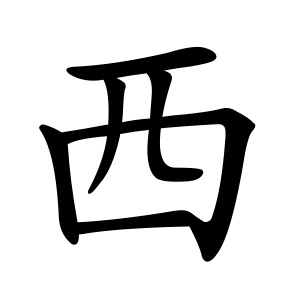西
- west;
- the western direction;
by extension, the West (Europe, Western lands).
Also used as a phonetic loan for Spain (西班牙).
Etymology
Ancient forms show a bag or nest shape. Early oracle bone inscriptions suggest it depicted a bird’s nest or a backpack, though its precise link to “west” is uncertain.
Later interpretations saw it as a symbol of the sun setting in the west, connected with “going home” at dusk.
Related forms:
• Variant: 㢴 (older form preserving bronze/clerical style)
Usage in Korean
大西洋 (대서양) — Atlantic Ocean
佛蘭西 (불란서) — France
西歐 (서구) — Western Europe
西方 (서방) — the West; western lands
西洋 (서양) — the West, Western world
偏西風 (편서풍) — westerlies (west wind)
Words that derived from 西
Additional notes
In Buddhism, 西方 (“the Western direction”) became strongly associated with the Pure Land (西方極樂世界) of Amitābha Buddha, a paradise where believers aspire to be reborn.
In Chinese cosmology, the west corresponds to autumn and the element metal (金) in the Five Phases (五行). It is also linked with the White Tiger (白虎) among the Four Symbols (四象).
In Daoist and Confucian cosmology, 西 marks the time of decline and harvest — the sun setting, the completion of cycles.
Alternative forms
The 3rd stroke shape differs across regions:
Japan/Korea: hook form (乚).
Mainland China: simple vertical curve (like ㄴ).
